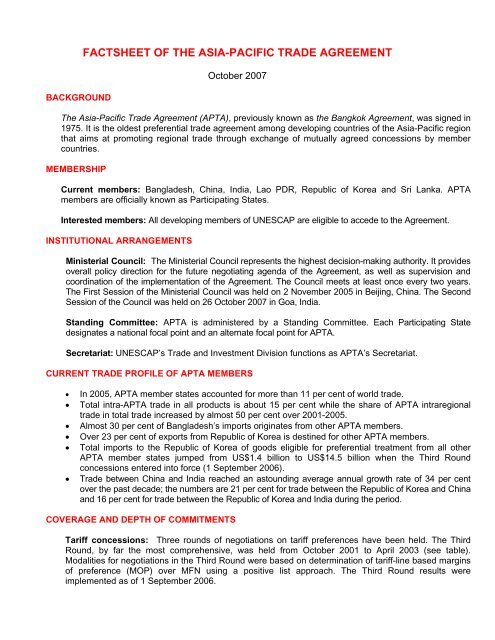Factsheet of the Asia-Pacific Trade Agreement, Oct 2007 - Escap
Factsheet of the Asia-Pacific Trade Agreement, Oct 2007 - Escap
Factsheet of the Asia-Pacific Trade Agreement, Oct 2007 - Escap
Create successful ePaper yourself
Turn your PDF publications into a flip-book with our unique Google optimized e-Paper software.
BACKGROUND<br />
FACTSHEET OF THE ASIA-PACIFIC TRADE AGREEMENT<br />
<strong>Oct</strong>ober <strong>2007</strong><br />
The <strong>Asia</strong>-<strong>Pacific</strong> <strong>Trade</strong> <strong>Agreement</strong> (APTA), previously known as <strong>the</strong> Bangkok <strong>Agreement</strong>, was signed in<br />
1975. It is <strong>the</strong> oldest preferential trade agreement among developing countries <strong>of</strong> <strong>the</strong> <strong>Asia</strong>-<strong>Pacific</strong> region<br />
that aims at promoting regional trade through exchange <strong>of</strong> mutually agreed concessions by member<br />
countries.<br />
MEMBERSHIP<br />
Current members: Bangladesh, China, India, Lao PDR, Republic <strong>of</strong> Korea and Sri Lanka. APTA<br />
members are <strong>of</strong>ficially known as Participating States.<br />
Interested members: All developing members <strong>of</strong> UNESCAP are eligible to accede to <strong>the</strong> <strong>Agreement</strong>.<br />
INSTITUTIONAL ARRANGEMENTS<br />
Ministerial Council: The Ministerial Council represents <strong>the</strong> highest decision-making authority. It provides<br />
overall policy direction for <strong>the</strong> future negotiating agenda <strong>of</strong> <strong>the</strong> <strong>Agreement</strong>, as well as supervision and<br />
coordination <strong>of</strong> <strong>the</strong> implementation <strong>of</strong> <strong>the</strong> <strong>Agreement</strong>. The Council meets at least once every two years.<br />
The First Session <strong>of</strong> <strong>the</strong> Ministerial Council was held on 2 November 2005 in Beijing, China. The Second<br />
Session <strong>of</strong> <strong>the</strong> Council was held on 26 <strong>Oct</strong>ober <strong>2007</strong> in Goa, India.<br />
Standing Committee: APTA is administered by a Standing Committee. Each Participating State<br />
designates a national focal point and an alternate focal point for APTA.<br />
Secretariat: UNESCAP’s <strong>Trade</strong> and Investment Division functions as APTA’s Secretariat.<br />
CURRENT TRADE PROFILE OF APTA MEMBERS<br />
• In 2005, APTA member states accounted for more than 11 per cent <strong>of</strong> world trade.<br />
• Total intra-APTA trade in all products is about 15 per cent while <strong>the</strong> share <strong>of</strong> APTA intraregional<br />
trade in total trade increased by almost 50 per cent over 2001-2005.<br />
• Almost 30 per cent <strong>of</strong> Bangladesh’s imports originates from o<strong>the</strong>r APTA members.<br />
• Over 23 per cent <strong>of</strong> exports from Republic <strong>of</strong> Korea is destined for o<strong>the</strong>r APTA members.<br />
• Total imports to <strong>the</strong> Republic <strong>of</strong> Korea <strong>of</strong> goods eligible for preferential treatment from all o<strong>the</strong>r<br />
APTA member states jumped from US$1.4 billion to US$14.5 billion when <strong>the</strong> Third Round<br />
concessions entered into force (1 September 2006).<br />
• <strong>Trade</strong> between China and India reached an astounding average annual growth rate <strong>of</strong> 34 per cent<br />
over <strong>the</strong> past decade; <strong>the</strong> numbers are 21 per cent for trade between <strong>the</strong> Republic <strong>of</strong> Korea and China<br />
and 16 per cent for trade between <strong>the</strong> Republic <strong>of</strong> Korea and India during <strong>the</strong> period.<br />
COVERAGE AND DEPTH OF COMMITMENTS<br />
Tariff concessions: Three rounds <strong>of</strong> negotiations on tariff preferences have been held. The Third<br />
Round, by far <strong>the</strong> most comprehensive, was held from <strong>Oct</strong>ober 2001 to April 2003 (see table).<br />
Modalities for negotiations in <strong>the</strong> Third Round were based on determination <strong>of</strong> tariff-line based margins<br />
<strong>of</strong> preference (MOP) over MFN using a positive list approach. The Third Round results were<br />
implemented as <strong>of</strong> 1 September 2006.
Concession Before Third Round<br />
After Third Round<br />
Offering Country No. <strong>of</strong> MOP (%) No. <strong>of</strong> MOP (%)<br />
Products<br />
Products<br />
Bangladesh 129 14.0 209 14.1<br />
China b 902 (18) 15.4 (55.1) 1,697 (161) 26.7 (77.9)<br />
India 188 (33) 52.6 (32.2) 570 (48) 23.9 (39.7)<br />
Rep <strong>of</strong> Korea 214 (29) 30.3 (38.2) 1,367 (306) 35.4 (64.6)<br />
Sri Lanka 288 (32) 17.8 (14.0) 427 (72) 14.0 (12.0)<br />
Total 1,721 (112) 21.6 (32.2) 4,270 (587) 26.8 (58.8)<br />
Note: numbers in brackets indicate special concessions for LDC members only<br />
Rules <strong>of</strong> origin: 45 per cent local value addition, 35 per cent for LDC members. Cumulation: <strong>the</strong><br />
aggregate content originating in <strong>the</strong> territory <strong>of</strong> <strong>the</strong> Participating States is not less than 60 per cent <strong>of</strong><br />
its f.o.b. value (50 per cent for LDC members). The Second Session <strong>of</strong> <strong>the</strong> Ministerial Council adopted<br />
a set <strong>of</strong> Operational Procedures for <strong>the</strong> Certification and Verification <strong>of</strong> <strong>the</strong> Origin <strong>of</strong> Goods under<br />
APTA, which is a first among regional trade agreements in <strong>the</strong> <strong>Asia</strong>-<strong>Pacific</strong> region.<br />
Implementation results: The utility and coverage ratios as well as <strong>the</strong> utilization rates are only<br />
available for China and <strong>the</strong> Republic <strong>of</strong> Korea for <strong>the</strong> ten month period following <strong>the</strong> implementation<br />
date <strong>of</strong> <strong>the</strong> Third Round (1 September 2006) in <strong>the</strong> table below.<br />
Imports from all Coverage Ratio Utilization Rate Utility Ratio<br />
APTA members by:<br />
China 13.5 24.8 3.3<br />
Rep. <strong>of</strong> Korea 27.8 13.4 3.7<br />
ACCESSION PROCESS<br />
1. Notification to UNESCAP secretariat<br />
2. <strong>Agreement</strong> <strong>of</strong> existing members to start accession negotiations<br />
3. Bilateral negotiations<br />
4. Multilateralization <strong>of</strong> negotiation results<br />
5. Deposit <strong>of</strong> instrument <strong>of</strong> accession<br />
THE WAY FORWARD<br />
Fourth Round <strong>of</strong> negotiations: At <strong>the</strong> Second Session <strong>of</strong> <strong>the</strong> Ministerial Council, APTA members<br />
launched <strong>the</strong> fourth round <strong>of</strong> negotiations which covers deepening and widening tariff concessions and<br />
include o<strong>the</strong>r areas such as non-tariff barriers, trade facilitation, services and investment among o<strong>the</strong>rs.<br />
The Fourth Round is scheduled for completion by <strong>Oct</strong>ober 2009.<br />
Expansion <strong>of</strong> membership: APTA members have committed to take on direct responsibilities for <strong>the</strong><br />
expansion <strong>of</strong> membership to make APTA a truly <strong>Asia</strong>n and <strong>Pacific</strong> trade agreement based on a list <strong>of</strong><br />
priority countries.
















